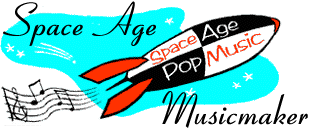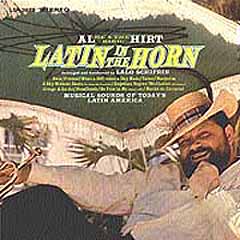Home · Listener's Guide · The Songs · Who's Who · Liner Notes · Selected Tracks · What's New · Search

Al Hirt
- Born 7 November 1922, New Orleans, Louisiana
- Died 27 April 1999, New Orleans, Louisiana
 A phenomenally proficient trumpet player, Al Hirt was one of the most successful instrumental recording artists of the 1960s. Perhaps modeling his genial stage personality after Louis Armstrong, Hirt was a tremendously popular performer, easily capturing the center of attention with his massive 300-pound, 6-foot-2 frame (among his nicknames were "Jumbo" and "The Round Mound of Sound") but holding it with his joyful spirit and jaw-dropping virtuosity.
A phenomenally proficient trumpet player, Al Hirt was one of the most successful instrumental recording artists of the 1960s. Perhaps modeling his genial stage personality after Louis Armstrong, Hirt was a tremendously popular performer, easily capturing the center of attention with his massive 300-pound, 6-foot-2 frame (among his nicknames were "Jumbo" and "The Round Mound of Sound") but holding it with his joyful spirit and jaw-dropping virtuosity.
Although Hirt came out of New Orleans leading a Dixieland band, he never let himself get stereotyped in that narrow genre. He was honest about his choice of style, never calling what he played "jazz": "I'm a pop commercial musician," he once said. "and I've got a successful format. I'm not a jazz trumpet and never was a jazz trumpet."
Hirt's father bought him his first trumpet from a pawnshop, and by the time he was in high school, he was sounding post time at the local race track. Hirt was always very serious about perfecting his mastery of his instrument, and he studied at the Cincinnati Conservatory for three years in the early 1940s. After playing with Army bands during World War Two, he worked with Tommy Dorsey, Ray McKinley, and Benny Goodman's big bands--usually as first chair, but not a soloist--until he returned to New Orleans and formed his own band in 1950.
For most of the 1950s, he was comfortable staying close to home--musically and professionally. Raising eight kids with his first wife probably had something to do with it, but Hirt was always happy to have a strong association with the music and lifestyle of New Orleans. He often performed with clarinet player Pete Fountain, who achieved nearly the same level of national fame, and the two remained close friends and colleagues until Hirt's death. Hirt recorded a number of mainstream Dixieland albums for Audio Fidelity and others during this period.
In 1960, Hirt's group, the Dixieland Six, played Las Vegas and was spotted by Dinah Shore, who booked them onto her television variety show. Television and Hirt took to each other, and RCA quickly signed him and began promoting him as a major artist. To get and keep a national audience, Hirt had to loosen his ties to Dixieland. Virtually none of his RCA albums have a strong Dixieland flavor, most of them featuring large studio ensembles and arrangements by veterans like Marty Paich, Billy May, and Marty Gold. His albums Honey in the Horn and Cotton Candy were both gold records, and he was named "Top Instrumentalist" by Billboard magazine in 1965.
Hirt never turned his back on his roots, though, and at the same time he was coming to fame, he opened his own night club in the French Quarter and appeared there regularly. Although he toured steadily well into the 1980s, often in pops concerts with symphony orchestras, he tried to work his schedules to bring him back home quickly. His 1965 album with Arthur Fiedler and the Boston Pops was among his best-selling records, and Hirt enjoyed playing classical showpieces as well as popular numbers. He said that playing Handel's "Ave Maria" for Pope John Paul's 1987 visit to New Orleans was his most important performance.
Hirt's weight and lifestyle eventually took its toll on his body, and in later years, he had to perform in a wheelchair. He closed his club in 1983, fed up with the deterioration of the French Quarter, but he continued to play there, mostly at Fountain's club, until a few months before his death.
Recordings
- Java, Accord 7187
- Swingin' Dixie, Audio Fidelity AFS 5877
- Swingin' Dixie, Vol. 2, Audio Fidelity AFS 5878
- Swingin' Dixie, Vol. 3, Audio Fidelity AFS 5926
- Swingin' Dixie, Vol. 4, Audio Fidelity AFS 5927
- In New Orleans, Coral CRL 57402
- Floatin' Down to Cotton Town, MCA 20072
- He's the King, RCA Victor LSP-2354
- The Greatest Horn in the World, RCA Victor LSP-2366
- Horn-a-Plenty, RCA Victor LSP-2446
- At the Mardi Gras, RCA Victor LSP-2497
- Trumpet and Strings, RCA Victor LSP-2584
- Our Man in New Orleans, RCA Victor LSP-2607
- The Beauty and the Beard (with Ann-Margaret), RCA Victor LSP-2690
- Pops Goes the Trumpet, RCA Victor LSP-2729
- Honey in the Horn, RCA Victor LSP-2733
- Cotton Candy, RCA Victor LSP-2917
- Sugar Lips, RCA Victor LSP-2965
- The Best of, RCA Victor LSP-3309
- That Honey Horn Sound, RCA Victor LSP-3337
- Live at Carnegie Hall, RCA Victor LSP-3416
- They're Playing Our Song, RCA Victor LSP-3492
- The Best of, Vol.2, RCA Victor LSP-3556
- The Happy Trumpet, RCA Victor LSP-3579
- Music to Watch Girls By, RCA Victor LSP-3773
- Plays Bert Kaempfert, RCA Victor LSP-3917
- Unforgettable, RCA Victor LSP-3979
- In Love with You, RCA Victor LSP-4020
- Here in My Heart, RCA Victor LSP-4161
- Al Hirt, RCA Victor LSP-4247
- This is Al Hirt, RCA Victor LSP-6025
- Struttin' Down Royal Street, RCA Camden CAS-2138
- Al's Place, RCA Camden CAS-2316
- Have a Merry Little Christmas, RCA Camden CAS-2573
- The Very Best of Al Hirt and Pete Fountain, MGM 4216
- Super Jazz, Monument 8602
- Greatest Hits, BMG/RCA CD
- Music to Watch Girls By, BMG/RCA CD
- Cocktail Hour, RCA CD
- Honey in the Horn/Our Man in New Orleans, BMG/RCA CD
Al Hirt.-->
S p a c e A g e P o p M u s i c
Home · Listener's Guide · The Songs · Who's Who · Liner Notes · Selected Tracks · What's New · Search
Email: editor@spaceagepop.com